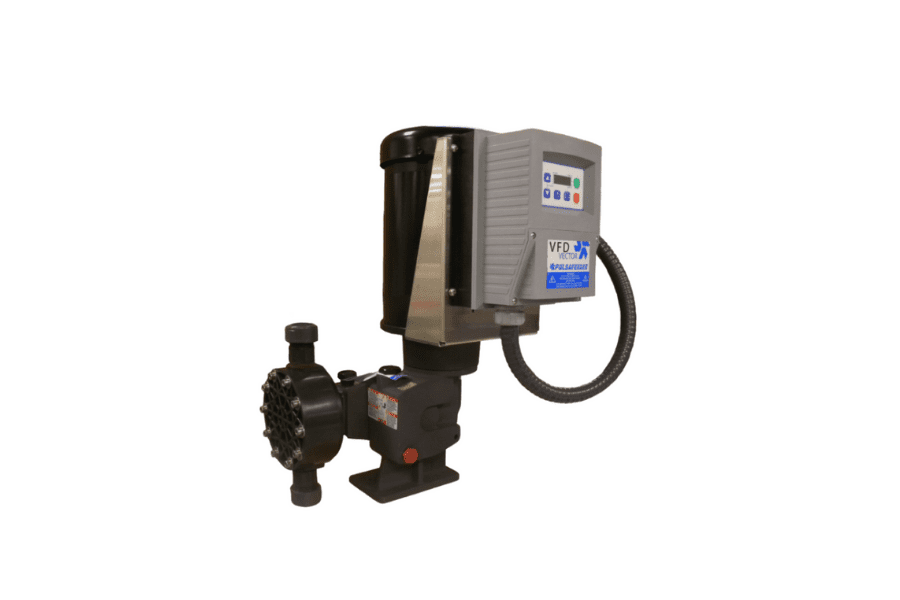
Pumps Commonly Used for Metering Systems
When selecting or specifying a chemical metering system, it’s important to know the many options that exist in metering pump technology. Most people are familiar with the diaphragm and peristaltic metering pump, but there are other options with distinct advantages in certain application situations. Here, we discuss the pros and cons of the most available options.
Diaphragm Metering Pumps
The workhorse of the chemical metering industry, diaphragm pumps are, by far, the most common style. A reciprocating diaphragm compresses and decompresses the liquid chamber while check valves on the suction and discharge force the liquid to flow in the desired direction. The metered flow rate is proportional to the displacement of the liquid chamber multiplied by the number of strokes per minute: precise flow proportional to the stroke speed of the diaphragm.
Pros
- Relatively low cost
- Wide range of materials of construction; compatible with most chemicals
Cons
- Pulsation can cause piping/system damage, especially in larger pumps
- Pulsing flow is more difficult to measure with flow meters
- Long time between chemical doses at low flow rates (slug dosing)
Peristaltic Metering Pumps
A hose or tube is contained in a “C” channel and compressed by a two or three roller rotor that traps liquid between rollers and forces it towards the discharge. The metered flow is proportional to the rotational speed of the rotor.
Pros
- Can run dry and pump gases; excellent for chemicals that tend to naturally off-gas
- Very low shear
- Can handle liquids that contain solids (slurries)
- Excellent suction capability
Cons
- Mechanical wear on the hose results in frequent maintenance
- If the hose breaks, the leaking chemical can cause damage and is a personnel issue
- Hoses are limited to elastomeric compounds, which limits chemical compatibility
Magnetic-Drive Gear Pump
A rotary, positive displacement pump, gears pumps create flow using two meshed gears housed in the pump’s body cavity. Liquid is trapped in the gear teeth as they rotate away from each other at the suction and is forced out the discharge when the gear teeth mesh on the discharge side. The metered flow is proportional to the volume of the gear tooth gaps times the number of revolutions per minute. These pumps are exceptionally precise.
Pros
- Very smooth flow with virtually no pulsation
- Wide range of materials of construction
- 100% leak-free design
Cons
- Cannot pump solids
Magnetic-Drive Vane Pump
Another rotary, positive displacement pump, vane pumps use an eccentric rotor with embedded carbon-graphite vanes. Liquid is trapped between the vanes in the open section of the cavity as they rotate away from suction and is forced out the discharge when the vane cavity is compressed on the discharge side. The metered flow is proportional to the volume between the vanes times the number of revolutions per minute. These pumps are also exceptionally precise.
Pros
- Very smooth flow with virtually no pulsation
- Wide range of materials of construction
- 100% leak-free design
- Capable of handling very low NPSHa
Cons
- Cannot pump solids.
Generalized recommendations:
- Less than 200 LPH metering: Diaphragm or peristaltic
- Greater than 200 LPH metering: Mag-Drive gear or vane
- Systems requiring flow measurement: Mag-Drive gear or vane
- System with large turndowns: Peristaltic or mag-drive gear
- Liquids containing solids: Peristaltic; possibly diaphragm
When it comes to chemical metering pumps, choosing one that meets your needs and makes the most sense for your business is critical. You can’t afford to have anything less than a reliable system you can count on time after time for years to come. Fortunately, multiple options are available to deliver safe, high-quality results.
What you choose will depend on what you feel comfortable with and the specifications you are looking for. Four main types will be at your disposal to purchase and use. These are the diaphragm, peristaltic, magnetic-drive gear, and magnetic-drive vane. All four have advantages and drawbacks, so you can’t really go wrong. You will first want to understand how each one works and what you can expect from it.
You can then examine each type of pump and what it does best and where it has limitations. Evaluate what type of work it performs most effectively. Then, consider your business needs and which pump or pumps would best accomplish your tasks. Once you do this, you can be ready to purchase pumps for your metering system. You can then have peace of mind that you will have all the tools and resources you need to deliver for your customers.
